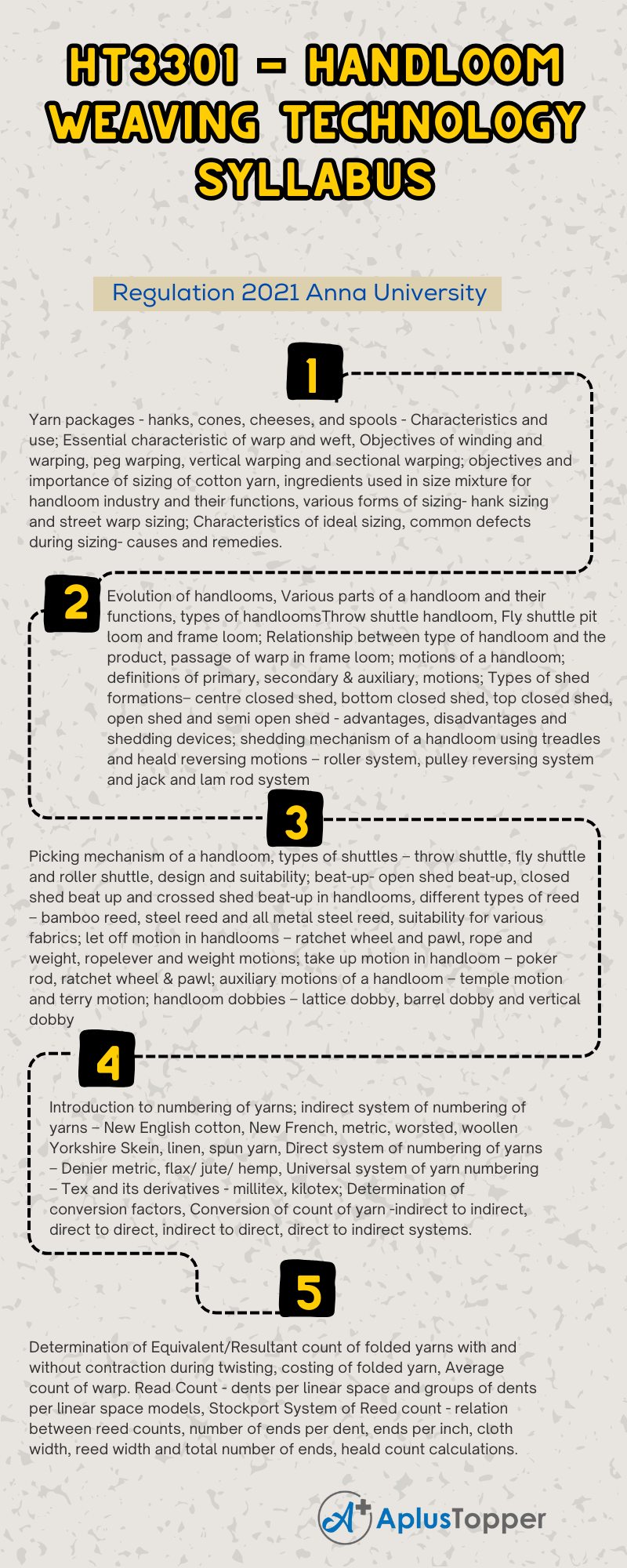Anna University Handloom and Textile Technology syllabus of B. Tech. Handloom and Textile Technology Semester III. In this article, we are glad to provide the syllabus of the Handloom Weaving Technology.
We aim to provide the following semester HT3301 – Handloom Weaving Technology syllabus in a detailed manner. We include the appropriate syllabus textbooks and references. Hope this information is useful. Don’t forget to share with your classmates.
If you want to know more about the B. Tech. Handloom and Textile Technology Syllabus is connected to an affiliated institution’s four-year undergraduate degree program. We provide you with a detailed Year-wise, semester-wise, and Subject-wise syllabus in the following link B. Tech. Handloom and Textile Technology Syllabus Regulation 2021 Anna University.
Aim Of Objectives:
- To enable the students to understand the principles of mechanisms of handloom weaving such as primary, secondary and auxiliary motions, preparatory processes, yarn packages etc.,
- To enable the students to perform calculations of yarn count, reed count and heald count
- To enable the students to gain the knowledge of the principles of working of various handloom dobbies
HT3301 – Handloom Weaving Technology Syllabus
Unit – I: Weaving Preparatory Process
Yarn packages – hanks, cones, cheeses, and spools – Characteristics and use; Essential characteristic of warp and weft, Objectives of winding and warping, peg warping, vertical warping and sectional warping; objectives and importance of sizing of cotton yarn, ingredients used in size mixture for handloom industry and their functions, various forms of sizing- hank sizing and street warp sizing; Characteristics of ideal sizing, common defects during sizing- causes and remedies.
Unit – II: Shedding And Picking Mechanism
Evolution of handlooms, Various parts of a handloom and their functions, types of handloomsThrow shuttle handloom, Fly shuttle pit loom and frame loom; Relationship between type of handloom and the product, passage of warp in frame loom; motions of a handloom; definitions of primary, secondary & auxiliary, motions; Types of shed formations– centre closed shed, bottom closed shed, top closed shed, open shed and semi open shed – advantages, disadvantages and shedding devices; shedding mechanism of a handloom using treadles and heald reversing motions – roller system, pulley reversing system and jack and lam rod system.

Unit – III: Beat-Up And Secondary Mechanism
Picking mechanism of a handloom, types of shuttles – throw shuttle, fly shuttle and roller shuttle, design and suitability; beat-up- open shed beat-up, closed shed beat up and crossed shed beat-up in handlooms, different types of reed – bamboo reed, steel reed and all metal steel reed, suitability for various fabrics; let off motion in handlooms – ratchet wheel and pawl, rope and weight, ropelever and weight motions; take up motion in handloom – poker rod, ratchet wheel & pawl; auxiliary motions of a handloom – temple motion and terry motion; handloom dobbies – lattice dobby, barrel dobby and vertical dobby.
Unit – IV: Yarn Numbering System
Introduction to numbering of yarns; indirect system of numbering of yarns – New English cotton, New French, metric, worsted, woollen Yorkshire Skein, linen, spun yarn, Direct system of numbering of yarns – Denier metric, flax/ jute/ hemp, Universal system of yarn numbering – Tex and its derivatives – millitex, kilotex; Determination of conversion factors, Conversion of count of yarn -indirect to indirect, direct to direct, indirect to direct, direct to indirect systems.
Unit – V: Yarn Count Caclculation
Determination of Equivalent/Resultant count of folded yarns with and without contraction during twisting, costing of folded yarn, Average count of warp. Read Count – dents per linear space and groups of dents per linear space models, Stockport System of Reed count – relation between reed counts, number of ends per dent, ends per inch, cloth width, reed width and total number of ends, heald count calculations.
Text Books:
- Sriramlu P.K., Ajgaonkar D.B. & Talukdar M.K., “Weaving Machines: Mechanisms, Management”, Mahajan Publishers, Ahmedabad, 1998.
- Lord P.R. and Mohammed M.H., “Weaving – Conversion of Yarn to Fabric”, Merrow Publication, 1992.
References:
- John A. Iredale “Yarn Preparation: A Hand Book”, Textile Institute, Manchester, 1992, ISBN: 1853390429
- Ormerod A. and Sondhelm W. S., “Weaving: Technology and Operations”, Textile Institute, 1995, ISBN: 187081276X.
Related Post:
Must Read:
